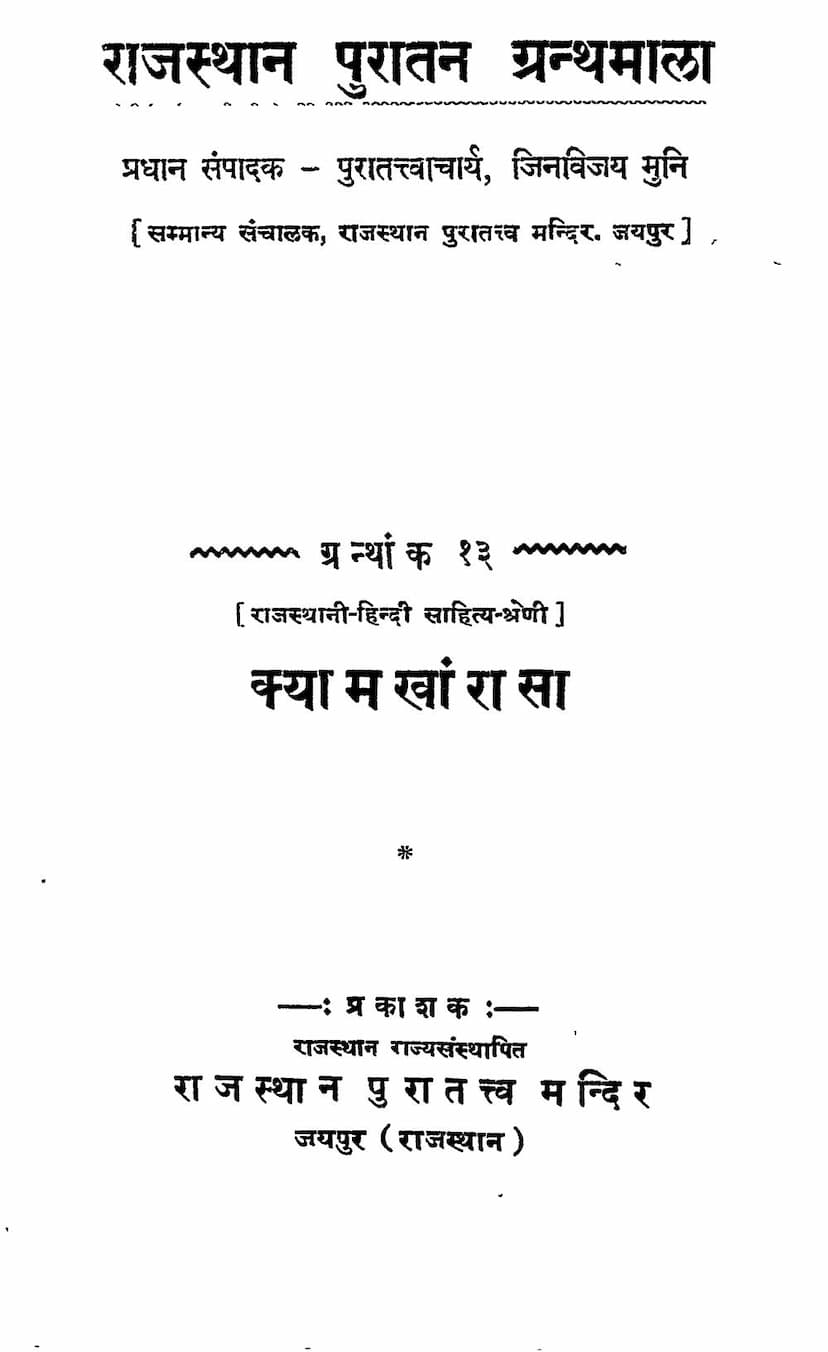Kyamkhanrasa
Added to library: September 2, 2025

Summary
Certainly, here's a comprehensive summary of the Jain text "Kyamkhanrasa" based on the provided pages:
Title: Kyamkhanrasa (or Kaymkhani Rasa)
Authors: Dashrath Sharma, Agarchand Nahta, Bhanvarlal Nahta
Publisher: Rajasthan Puratattvanveshan Mandir, Jaipur (Rajasthan)
Overview:
The Kyamkhanrasa is a significant historical and literary work authored by the Muslim poet Jan. It primarily focuses on the history and lineage of the Kaymkhani rulers, a dynasty that played a notable role in the region's history. The text is written in an early form of Rajasthani and is considered valuable for its linguistic and historical insights.
Key Features and Contents:
- Historical Narrative: The Rasa meticulously details the origins and genealogies of the Chauhan dynasty, to which the Kaymkhani rulers traced their lineage. It recounts the transformation of a Chauhan prince, Karamchand, into Kaym Khan, who then embraced Islam and established the Kaymkhani rule. The text chronicles the reigns and significant events involving various Kaymkhani rulers, including their military campaigns, administrative activities, and interactions with other regional powers and the Mughal emperors.
- Biographical Details: The book provides biographical sketches of key figures, particularly focusing on the poet Jan himself, his family, and patrons. It explores Jan's background as a Muslim poet who wrote extensively on Hindu themes and patrons, highlighting his literary skills and the breadth of his work, which spanned various subjects.
- Linguistic Significance: The text is important for its linguistic value. It is written in an early Rajasthani dialect, displaying characteristics of both Apabhramsha and early Rajasthani, with influences from Sauraseni. The editors emphasize its importance for philological studies, as it exhibits less of the artificial 'Dangal' vocabulary found in later Charan poetry.
- Poetic Style: Jan's writing style is described as natural, simple, and powerful. It avoids excessive ornamentation and is characterized by a flowing and engaging narrative, making it a compelling read.
- Detailed Genealogies and Appendices: The book includes extensive appendices that provide a comprehensive understanding of the Kaymkhani lineage. These include:
- Genealogical charts (vansh vriksha) of the Kaymkhani rulers.
- Information on villages founded by the Kaymkhani nawabs.
- Details about the origins of the Kaymkhani nawabs.
- Information about subsequent nawabs.
- Works authored by Diwan Daulat Khan.
- Scholarly Editing and Introduction: The Rasa has been meticulously edited by scholars Dashrath Sharma, Agarchand Nahta, and Bhanvarlal Nahta. They have provided a detailed introduction (bhumika) and historical commentary, offering insights into the poet Jan, his works, the historical context of the Rasa, and its significance. The editors acknowledge the limitations of working with a single manuscript copy and appeal for the discovery of other manuscripts for a more definitive edition.
- Historical Evaluation: The editors and contributing scholars analyze the Rasa's historical accuracy, noting that while the narrative is often embellished with poetic license, it provides valuable contemporary accounts of the Kaymkhani dynasty and their impact on the region. The text is seen as a primary source for understanding this particular ruling lineage.
- Literary and Cultural Context: The introduction places the work within the broader context of Rajasthani literature, comparing it to other significant Rasa and Khyat literature. It highlights Jan's unique position as a Muslim poet contributing significantly to the literary landscape.
- Early Rajasthani and Gujarati Linguistic Connection: The introduction also touches upon the linguistic connections between early Rajasthani and Gujarati, discussing terms like "Sorth-Maru" language used in other contemporary texts, drawing parallels with the linguistic study of the Rasa.
In essence, the Kyamkhanrasa, as presented in this scholarly edition, is a foundational text for understanding the history of the Kaymkhani rulers. It is also a significant piece of early Rajasthani literature, celebrated for its historical detail, poetic merit, and linguistic value, meticulously brought to light by the editorial efforts of Sharma, Nahta, and Nahta.